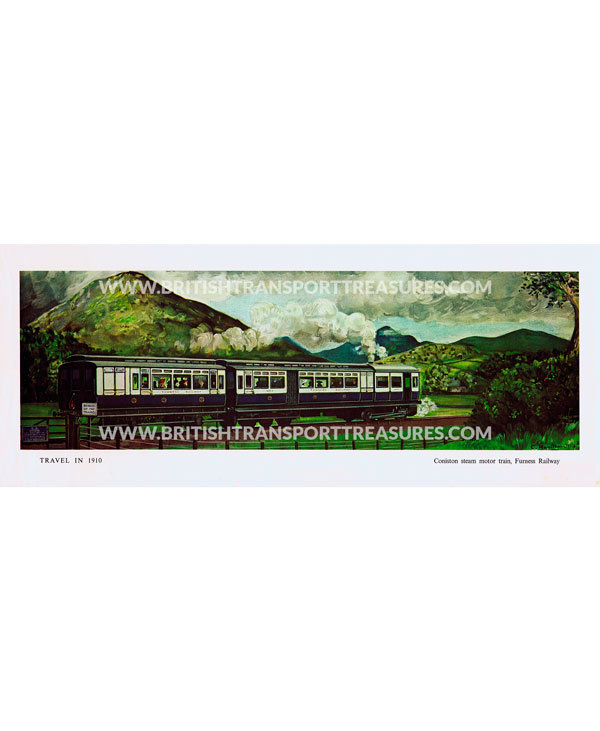Description
In the days when the majority of railway carriages were of the separate compartment type, rather than the open saloons of today, the only alternative to looking out of the window to making unwelcome eye contact with the strangers opposite, was to stare at the luggage rack. A number of railways adopted the scheme of displaying two or three sepia photographs of places served by the line in the space between the opposing passenger’s heads, and the luggage rack. These were of the “Promenade at Cleethorpes” variety, and were still in situ in elderly carriages, long after the straw boaters and long dresses of the figures depicted had ceased to be fashionable. Between the Wars, attractive water-colours of villages, landscapes and historic buildings were commissioned from well-known artists for use in new rolling stock.
However, apart from the occasional viaduct, few were of direct railway interest. Around 1950, George Dow, P.R& P.O of the London Midland Region, and already a noted railway historian, decided to brighten up travel in bleak austerity Britain, by commissioning railway author and artist Cuthbert Hamilton Ellis (1909-1987) to produce 24 oil paintings on the theme of “Travel in…” featuring colourful trains and ships which had belonged to companies swallowed up in the former London Midland & Scottish Railway in 1923. This, featuring a scene in 1910, was No.19 in the set with dates ranging from 1835, to 1920.
The steam railmotor was a quintessentially Edwardian vehicle, retaining much of the elegance of the previous decade, coupled with the best that contemporary technology could provide to help save operating costs in the face of rising wages, shorter working hours and increasing competition. Most of the major English companies (but only two of the Scottish ones) tried them, before their built in disadvantages – excessive vibration, due to the engine being combined with the coach section, an inability to cope with a sudden increase in traffic, and difficulties in climbing gradients when full loaded. The biggest user was the GWR, who also persevered with them long after most other railways had given them up.
W.F. Pettigrew, Loco Supt. of the Furness Railway had a little more success with the two which he had built at the Company’s works at Barrow in Furness, in 1906, probably because they were designed for a specific job. This was to work the Coniston Branch with its long ruling gradient of 1 in 49. The secret was plenty of steam, from a boiler and firebox combination offering 500 sq.ft.of heating surface, and small coupled driving wheels of 2ft. 10 ins. Diameter. The cars were even capable of hauling a four wheeled driving trailer offering another 24 seats for passengers. However as wear and tear took effect, the vibration problem became worse, and they were withdrawn in 1914. The cars were unusual in several respects. First both engine and carriage portions were built by the railway – many other companies bought one or both from outside builders. Then they were the only locomotives built by the company in its own works, and the only locomotives which the Furness owned with Walschearts valve gear. Finally the carriage portions and the two trailers were the only clerestory roofed vehicles
This has been scanned to a very high resolution, and will take some time to download. If you put the download on a memory stick, take it to a Print Shop and tell them the size of the original image, they will be able to print it out full size for you on A2 paper.

Reviews
There are no reviews yet.